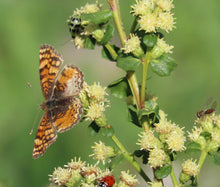
Baccharis pilularis
Coyote bush, also known as chaparral broom, is a drought-tolerant, evergreen shrub that is highly attractive to many native insects and birds, while being quite versatile and adaptable in a garden or landscape. It has a robust, upright form with bright green leaves that have a faint but pleasant aroma on warm sunny days. Small but abundant white to yellow flowers appear in late summer and continue blooming and provide critical floral resources well into fall, after nearly everything else is done flowering.
- Plant type/canopy layer: evergreen, perennial, large shrub
- Size at maturity: 1'-15' tall, 2'-9' wide
- Light requirements: full sun, part sun/part shade
- Moisture requirements: dry soil, prefers well-drained soil
- Bloom time: August - November
- Growth rate/ease: medium growth rate, easy to grow (in the right conditions)
- Wildlife support: flowers are a late season nectar source for adult butterflies, bees and other insect pollinators; overall plant provides exceptional foraging and refugia habitat for birds and other small animals, attracts beneficial and pest eating insects, and is a caterpillar host plant and larval food source for native moths and butterflies
- Native habitat/range: native to and common throughout coastal Oregon and the central Cascades. Portland Plant List - no.
- Special features & uses: pollinator powerhouse; evergreen; deer resistant; fire resistant; landscape uses include bank stabilization, erosion control and habitat hedgerows
Gardening with Coyote Bush: In the garden, coyote bush is perfect for sunny slopes, rocky driveways, rock gardens and pollinator gardens. Although it prefers well-drained soil, it can grow in most soil conditions from moist and clay-rich to dry and rocky and requires minimal to no summer irrigation. It is hardy as heck; tolerant of drought and heat and largely fire and deer resistant (light grazing stimulates new growth). It can be used in a sunny habitat hedgerow, on an exposed slope for bank stabilization, or in areas that are prone to erosion. It also functions nicely as cover for other native perennials to establish themselves. In the wild, this hardy shrub is "pruned" by periodic fires and light grazing (deer, elk, etc). In home gardens, it takes very well to pruning that simulates these natural cycles. Try pruning it to your desired form, usually mounding or tree-like, in mid-winter every couple years and the new spring growth will be revitalized and robust.
Photo Credit 1: © Jesse Rorabaugh, some rights reserved (CC-BY)
Photo Credit 2: © LJ Moore-McClelland, some rights reserved (CC-BY)
Photo Credit 3 & 8: © Ken-ichi Ueda, some rights reserved (CC-BY)
Photo Credit 4: © icosahedron, some rights reserved (CC-BY)
Photo Credit 5: © David Anderson, some rights reserved (CC-BY)
Photo Credit 6: © Isaac Krone, some rights reserved (CC-BY)
Photo Credit 7: © Michael Warner, some rights reserved (CC-BY)
Photo Credit 9: © Peter Brastow, some rights reserved (CC-BY)

















